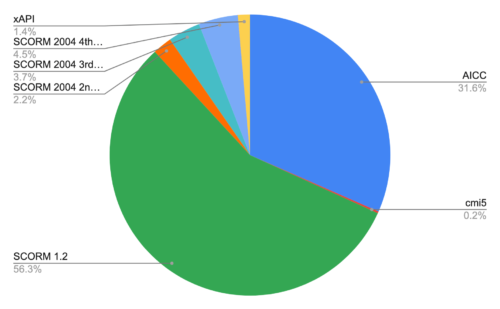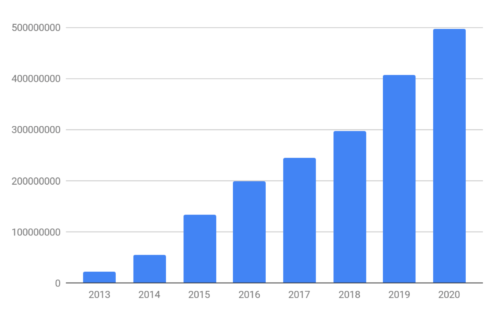“Ain’t no party like an xAPI party.” That’s how it goes, right? The xAPI Learning Cohort recently hosted the first-ever around the clock xAPI Party for explorers and strategic thinkers who use xAPI. The party was filled with case studies, how-to webinars and demos. So when they asked us to share what trends we’re seeing with xAPI and cmi5 adoption, we were happy to present. And with more than 30,000 active SCORM Cloud users and 624,000 eLearning courses imported in 2020, we had quite the data set to comb through.
Packaged content

Since xAPI (previously Tin Can API) launched in 2012, we’ve seen 36,000 total xAPI course packages imported. So far in 2020, xAPI accounts for 1.4% of imports.
xAPI continues to steadily grow, but SCORM 1.2 still holds the lion’s share of imports at 56.3% followed by AICC with 31.6% of imports.
What’s interesting to note is that the two oldest standards (SCORM 1.2 and AICC) are still widely popular all these years later. Diving a little deeper and looking at courses launched in SCORM Cloud over the past year, SCORM 1.2 holds an even greater percentage at about 75%, followed by SCORM 4th edition. AICC is a noticeably smaller percentage. Users are likely testing the content for AICC conformance, but not using SCORM Cloud to deliver those courses.
Growing xAPI statement numbers

To date in 2020, we’ve seen nearly 500 million xAPI statements generated in SCORM Cloud, from both launches and outside content sending statements, which is roughly a 100 million more statements than in 2019.
If you’ve heard that no one is using xAPI, this graph shows incredible year-over-year growth and that xAPI is starting to take off. We’re looking forward to seeing if these trends continue next year.
Increasing number of xAPI adopters
The number of eLearning products supporting xAPI also continues to steadily increase across the industry. As of November, there are 26 ADL conformant Learning Record Stores (LRSs) and 52 vendors listed on ADL’s xAPI adopters registry.
LRSs aren’t the only growing market. Over the last several years, we’ve also seen the number of tools and products that support xAPI increasing, including content libraries, gaming platforms, simulations and mobile apps.
Even more interesting is that there are now 216 products and services on xAPI.com’s adopter list. In 2012, we weren’t sure if people would use this new xAPI thing, and now we’re seeing amazing growth.
cmi5 and future adoption
cmi5 is a “set of rules” that defines how to use xAPI in the context of an LMS or launch scenario. Since its introduction in 2017, cmi5 has seen more than 5,000 packaged content imports and accounts for 0.2% of course packages imported into SCORM Cloud this year.
While it may seem as though cmi5 adoption is increasing slowly, it’s actually growing faster than previous standards and is likely to ramp up even more over the next several years. In September, Rustici Software was awarded a contract for the ADL Initiative cmi5 Player and Test Suite (PTS) Prototype Project where we’ll develop and deliver tools and resources to aid adoption efforts of cmi6 and xAPI in the DoD, including an open-source cmi5 player.
Still reading? Then know that you are the one of the leaders and champions of the future of xAPI and cmi5 adoption. You’re the one who is solving the hard problems, and you understand the tools available to make those hard problems easier.
It’ll be exciting to see how the xAPI adoption numbers change over time, and we’ll continue sharing what we’re seeing at the 2021 parties.
If you’d like to learn more about xAPI and cmi5 by the numbers, view Chris Tompkins’s webinar from the xAPI Cohort. Ready to dive more into xAPI? Sign up for the next xAPI Learning Cohort starting Feb. 4. Best of all, the 12-week learning-by-doing experience is completely free!
Have questions about the data, xAPI, cmi5 or anything? Ask us! We love to chat.


